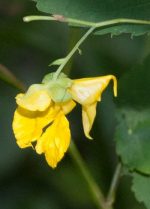 Also called, jewelweed, touch-me-not is an annual and a member of the balsam family, Balsaminaceae, that also includes busy lizzie. It is native to Canada and the US and grows in most of the states in the eastern part of the country. Plants prefer partial sun and wet to moist conditions but tolerates full sun and mesic conditions and can be found along ponds and streams, swamps, thickets, and moist woodland openings. The sap of the plants is used treat skin rashes caused by poison ivy or nettle stings.Description: With a shallow branching tap root, touch-me-not usually grows about three feet high but can reach six feet tall. The semi translucent stem is branched and carries oval leaves with pointed tips and scalloped edges. The leaves are pale green, up to four inches long, and are carried on long stems. The one inch wide flowers appear in pendent clusters of one to three and are pale yellow sometimes with red-brown spots in the throat. Each flowers has five petals that are fused into a cones with two large lower petals and one upper pe,tal being prominent and a curved spur on the back side of the flower. The bloom period lasts about two to three months beginning in mid summer and flowers give way to elongated seed pods up to two inches long that eject seed up to 15′ when disturbed. Plants spread by seeds that remain viable in the soil for about two years.
Also called, jewelweed, touch-me-not is an annual and a member of the balsam family, Balsaminaceae, that also includes busy lizzie. It is native to Canada and the US and grows in most of the states in the eastern part of the country. Plants prefer partial sun and wet to moist conditions but tolerates full sun and mesic conditions and can be found along ponds and streams, swamps, thickets, and moist woodland openings. The sap of the plants is used treat skin rashes caused by poison ivy or nettle stings.Description: With a shallow branching tap root, touch-me-not usually grows about three feet high but can reach six feet tall. The semi translucent stem is branched and carries oval leaves with pointed tips and scalloped edges. The leaves are pale green, up to four inches long, and are carried on long stems. The one inch wide flowers appear in pendent clusters of one to three and are pale yellow sometimes with red-brown spots in the throat. Each flowers has five petals that are fused into a cones with two large lower petals and one upper pe,tal being prominent and a curved spur on the back side of the flower. The bloom period lasts about two to three months beginning in mid summer and flowers give way to elongated seed pods up to two inches long that eject seed up to 15′ when disturbed. Plants spread by seeds that remain viable in the soil for about two years.
Control: Improve drainage and add sulfur to the soil to make habitat less favorable to touch-me-nots. Pull, dig , or mow plants before they set seed. In severe cases use the selective herbicide triclopyr in grassy areas or the non-selective glyphosate where none of the existing vegetation is wanted.